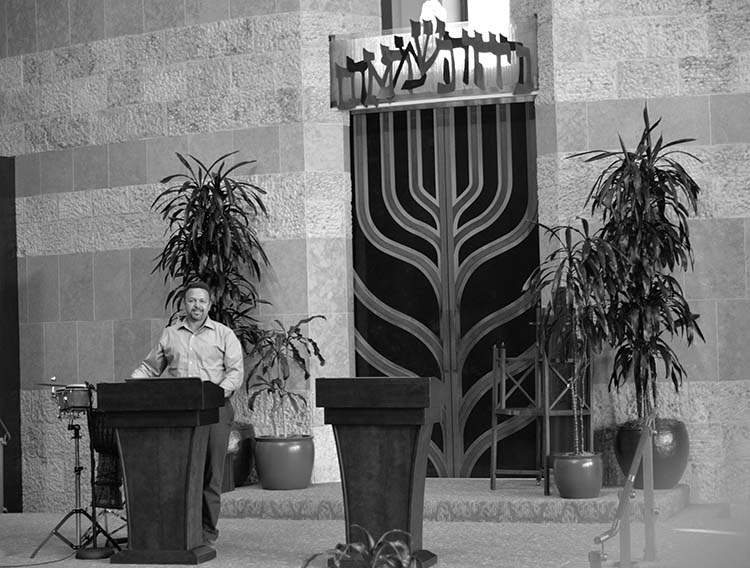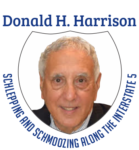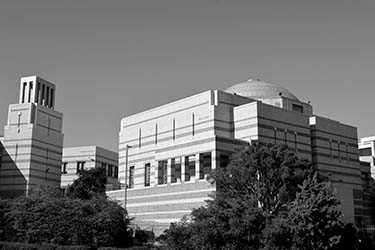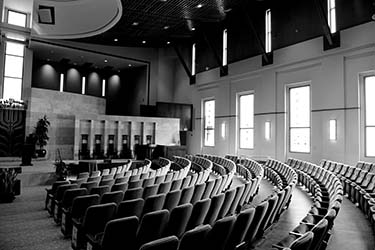 Editor’s Note: This is the 15th chapter in Volume 2 of Editor Emeritus Donald H. Harrison’s 2022 trilogy: “Schlepping and Schmoozing Along the Interstate 5.” All three books as well as others written by Harrison, may be purchased from Amazon.com. Harrison may be contacted via donald.harrison@sdjewishworld.com.
Editor’s Note: This is the 15th chapter in Volume 2 of Editor Emeritus Donald H. Harrison’s 2022 trilogy: “Schlepping and Schmoozing Along the Interstate 5.” All three books as well as others written by Harrison, may be purchased from Amazon.com. Harrison may be contacted via donald.harrison@sdjewishworld.com.
Schlepping and Schmoozing Along the Interstate 5, Exit 28A (Nobel Drive): Congregation Beth Israel
From the northbound Interstate 5, take the Nobel Road exit and turn right. Proceed east to a left turn at Towne Centre Drive. At the corner of Golden Haven Drive, turn right. Entrance to the parking lot of Congregation Beth Israel is at the left.

 SAN DIEGO — June Shapiro was a rebellious young woman. She felt the Orthodox Judaism in which her parents raised her was too restrictive. She decided to see more of New York than the section of the Bronx in which she was raised. In Manhattan, the rhythms of salsa and other Latin dances were inviting. Pedro Nevarez, a young man who had immigrated to New York City from Puerto Rico, via Chicago, romanced her. They were married and had a son Jason. When the boy was still a youngster, they learned that Pedro was the descendant of a well-known Spanish Jewish family that had become Conversos under the pressure of the Spanish Inquisition.
SAN DIEGO — June Shapiro was a rebellious young woman. She felt the Orthodox Judaism in which her parents raised her was too restrictive. She decided to see more of New York than the section of the Bronx in which she was raised. In Manhattan, the rhythms of salsa and other Latin dances were inviting. Pedro Nevarez, a young man who had immigrated to New York City from Puerto Rico, via Chicago, romanced her. They were married and had a son Jason. When the boy was still a youngster, they learned that Pedro was the descendant of a well-known Spanish Jewish family that had become Conversos under the pressure of the Spanish Inquisition.
Jason Nevarez, who later in life would become a Reform rabbi, grew up under the influence of two cultures He learned to speak both Spanish and English fluently, regularly ate Caribbean cuisine, participated in Latin ballroom dancing, and traveled frequently to Puerto Rico to visit relatives on his father’s side. Many of them lived in the town of Vega Baja.
Before their divorce when he was 12, Nevarez’s parents both worked full time, prompting them to move to the Riverdale section of New York to live near June’s parents, Sylvia and George Shapiro. The Shapiros helped to raise Jason; “I lived in this heavy, modern Orthodox Jewish environment for the early parts of my life,” Rabbi Nevarez said. “Because of my maternal grandparents, my upbringing, the Jewish component of my cultural and religious identity, was basically Ashkenazic practice.”
The rebbetzin at the synagogue where the Nevarez family worshiped was an amateur genealogist. She noticed that the “Nevarez” name was that of a distinguished Jewish family prior to the Spanish Inquisition. Nevarez did further research via ancestry.com, leading him to conclude that he would be eligible to apply for Spanish citizenship.

“I haven’t pursued it yet because the paperwork is immense,” Rabbi Nevarez, today the senior rabbi at Congregation Beth Israel, told me “I looked at it a couple of weeks ago, and I don’t have access to any kind of proof. Also, I asked myself, “So what if I can have a Spanish passport? What does that do for me? What is the point?’ I am not sure I will go for it.”
His parents’ diverse cultural backgrounds “in one way were symbiotic and, in others, very separate, Nevarez reflected. “At different times in my life, I was uncomfortable about them; I didn’t know how to wed the two.”
Later in life, however, “I have not only embraced it; it has actually extended my capacity to do what I do in the world, which is my rabbinate, and to be able to be in a relationship with different cultures and ethnicities because of my background.” For 17 years as a rabbi at Temple Shaaray Tefila in Bedford, New York (near Chappaqua and Armonk in northern Westchester County), “I worked with an NGO called Bridges to Community to do house building and cultural exchanges in the Dominican Republic and Nicaragua.”
The COVID-19 pandemic precluded Nevarez from continuing that work after he arrived at Beth Israel, but he told me in January 2022 that he plans to lead a delegation to the Dominican Republic when it is again safe to travel.
If the experiences of Beth Israel volunteers will follow the pattern of the Shaaray Tefila brigade, they will fly to the Dominican Republic, convert a church or a school into a temporary dormitory, and from that base build homes for community members who have deeds to the land where their shacks are built. The recipients will pay a small mortgage, the equivalent of $10 a month, with the proceeds going to the community to make microloans. Other projects over the week may be undertaken, including reforestation. At the end of the week, volunteers will celebrate Shabbat, with the services often attended by local Christian pastors.
Nevarez meanwhile became involved with the San Diego Social Justice Coalition’s efforts to help refugees who are waiting in Mexico for the opportunity to apply for asylum in the United States.
I asked him about his maternal side of the family. Grandfather George Shapiro, he said, was born in 1900 in Vilna, Lithuania, and immigrated to the United States when he was 8. His grandmother arrived in this country nine years later. George Shapiro served in the U.S. military during World War I, lying that he was older than 17 to do so. He was under arms again during World War II, serving as an electrician’s mate second class. The oldest enlisted man on the USS Franklin, his shipmates called him “Pop.” Well versed in Jewish liturgy, he led Jewish services on Shabbat and during holidays for approximately a half-dozen fellow Jews. The aircraft carrier, USS Franklin, nicknamed “The Big Ben” after its namesake Benjamin Franklin, was bombed by Japanese aircraft, with many men lost at sea.
According to a 1945 article in the Reform Advocate, Shapiro had been in the electric repair shop when the bombs hit. Initially he and other men in that area of the ship were trapped, but a Navy lieutenant was able to lead ten men at a time, including Shapiro, through air uptakes. Upon his escape from that situation, Shapiro joined a party of firefighters on the flight deck, ignoring an opportunity to scramble across a gangplank to the USS Santa Fe, which had pulled alongside. The ship limped back to a United States port, to considerable acclaim for the commander, Leslie Gehres, who later as a retired admiral served as chairman of the San Diego County Republican Central Committee for many years.
Shapiro was a natural athlete, having won letters in five sports at City College of New York and earning a place in that university’s hall of fame. According to Nevarez, nothing was more important to his grandfather than being a good, patriotic American. “He worked for many years in insurance and other things, and at the age of 68 became a teacher and did that through his 80s.”

With his grandfather, Nevarez traveled as a youngster to Washington D.C., to demonstrate on behalf of Soviet Jews, the “refuseniks” who regularly were refused permission to emigrate from their country. Grandfather Shapiro died when Nevarez was 17, and the funeral service was held by his Orthodox congregation. “My mother wanted to be part of the minyan, and they wouldn’t allow it,” he recalled. “I remember her having a fight with one of the fellows who came over; that was one of her issues with the Orthodox movement.”
His mother had worked as a consultant for several legal firms, having gone to law school but not having taken the New York State Bar Exam. His father meanwhile spent 40 years running therapeutic residential facilities for drug addicts.
Initially, Nevarez enrolled as an architecture major at the University of Michigan at Ann Arbor, but he decided that while he loved architecture, that major wasn’t for him. While at college, he and Charlie Cytron taught at the Torah school at Temple Beth Emeth. They later studied together for the rabbinate at Hebrew Union College’s campus in Jerusalem. Cytron, who changed his name to Cytron-Walker after marrying Adena Walker, was the rabbi in Colleyville, Texas, who was taken hostage with three of his congregants in January 2022. He was able to successfully lead an escape by throwing a chair at the gunman, who later was killed by SWAT officers.
Following his ordination, Neveraez served for 17 years at Shaaray Tefila, working his way up to rabbi from assistant rabbi and then associate rabbi. His wife Nicole is the chief executive officer of Ta’amod (Stand Up), an organization addressing the conditions necessary to create a safe, respectful Jewish workplace.
Eva Trieger, a columnist for San Diego Jewish World, reported that “unlike typical sexual harassment prevention ‘training,’ which tens towards legalistic and ‘what not to do’ approaches,” Ta’amod’s approach emphasizes making Jewish workplaces in the non-profit sector equitable and respectful of their employees.
The Nevarez family has two children, Ethan, who in 2022 was a student at Torrey Pines High School, and Sophie, who at that time was a pupil at the San Diego Jewish Academy.
*
Donald H. Harrison is editor emeritus of San Diego Jewish World. He may be contacted via donald.harrison@sdjewishworld.com